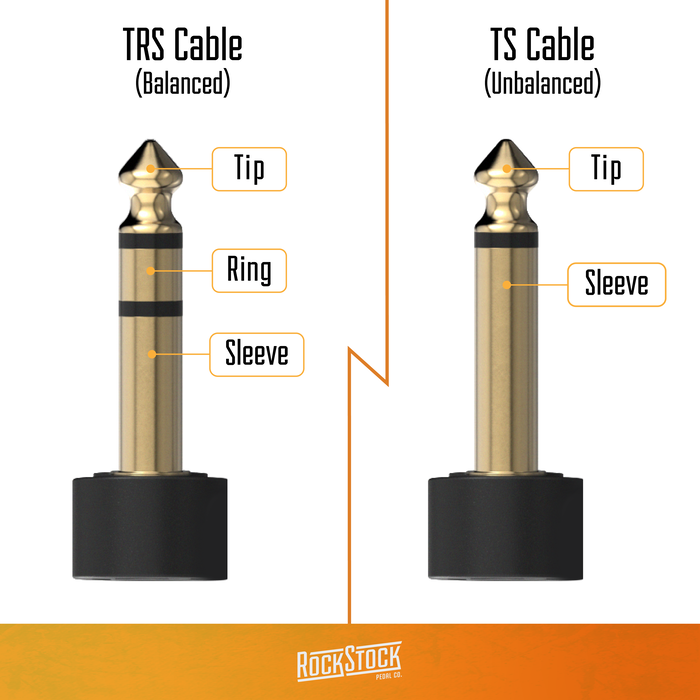Wired for Sound: A Musician's Guide to TS and TRS Cables

If you're as baffled as the guy in this gif, you're in the right place for a TS and TRS cable explainer.
Decoding the Basics: What are TS and TRS Cables?
A 'TS' (Tip Sleeve) cable is typically used for mono and unbalanced signals. You might say it's the 'solo artist' of cables, primarily found in guitars, basses, and certain keyboards. The 'TRS' (Tip Ring Sleeve) cable, on the other hand, is like the versatile band member, catering to both balanced mono and stereo signals.
The Key Differences: TS vs. TRS
- Mono vs. Stereo: TS cables are your go-to for unbalanced mono signals. On the other hand, TRS cables can handle balanced mono and stereo signals, making them a more versatile choice for different audio setups.
- Noise Interference: TRS cables generally offer lower noise interference compared to TS cables, which is a significant advantage in recording and live performance environments.
- Signal Carrying Capability: A TS cable carries a single audio signal, making it unsuitable for transmitting balanced audio. TRS cables, with their dual audio signals, are essential for achieving a full stereo experience.
- Applications: You’ll commonly use TS cables for connecting guitars, basses, and pedals to amplifiers. TRS cables find their place in more complex setups like connecting stereo headphones and microphones to mixing desks, pedalboard connections, etc.
Spotting the Difference Visually
Identifying TS and TRS cables is straightforward. Look for the black rings on the jack: TS cables have one ring, while TRS cables feature two. This visual cue corresponds to their internal wiring and signal carrying capabilities.

Common Misconceptions about TS and TRS Cables
-
"TRS Cables are Always Better Than TS Cables": This isn't necessarily true. The choice between TRS and TS cables depends on the application. For unbalanced mono signals, a TS cable is more appropriate.
-
"You Can Always Use TRS Cables for a Cleaner Sound": While TRS cables can carry balanced signals, which may reduce noise, they won’t improve sound quality if the source or destination is unbalanced.
-
"TS and TRS Cables Are Interchangeable Without Consequence": While they can often physically fit into the same jacks, using them interchangeably can result in lost stereo information, unbalanced signals, or unnecessary noise.
-
"Balanced Cables (TRS) Will Improve Any Audio Setup": Balanced cables are beneficial if the entire signal chain supports balanced audio. If any part of the chain is unbalanced, the benefits of a balanced cable are nullified.
-
"The More Rings on the Cable, The Better The Quality": The number of rings (one for TS, two for TRS) signifies the type of signal the cable carries, not the quality of the cable. Quality depends on factors like cable shielding, material, and construction.
Choosing the Right Cable for Your Gear
Selecting the appropriate cable for your musical gear is a bit like choosing the right outfit for an occasion; you need to match the gear’s requirements to the cable’s capabilities.
- Standard Electric Guitars and Basses: These typically require TS cables for their mono, unbalanced output. Think of a TS cable as the jeans-and-T-shirt combo of the audio world – simple, effective, and widely used. While you can technically use a TRS cable for a guitar or bass, it's overkill as these instruments typically output an unbalanced mono signal. It’s akin to driving a sports car for a quick trip to the grocery store – more capability than necessary, but it’ll still get you there.
- Acoustic-Electric Guitars: If they have onboard preamps and mixers, these might sometimes benefit from TRS cables for balanced connections, especially when longer cable runs are needed.
- Effects Loops and Pedals: For pedalboards, TS cables are generally used to chain effects pedals. However, some specialized pedals or multi-effects units might require TRS cables for certain functions or stereo outputs.
- Amplifiers and Mixing Desks: Some amplifiers and mixing desks can accept both TS and TRS connections. In these cases, using a TRS cable can offer the advantage of a balanced connection, reducing potential noise, especially over longer distances.
- Audio Interfaces and Recorders: For recording, especially in home studios, using TRS cables for connections to audio interfaces can improve signal integrity and reduce noise, as most interfaces are equipped to handle balanced signals.
Remember, the key is to understand the requirements of your specific equipment and the environment in which you’re using it. While TRS cables offer advantages in certain scenarios, TS cables are often sufficient for basic guitar-to-amplifier connections. As always, ensuring you have the right cable for the job can significantly improve your audio experience without unnecessary complications.
Enhancing Your Pedalboard Setup
For those perfecting their pedalboard setup, selecting the right cables is crucial. Our TS flat patch cables are specifically designed for connecting pedals (Shameless plug? YEP), offering a clean, reliable signal flow. For more advanced setups, like using an HX Stomp with an external dual switch, our TRS flat patch cables are the ideal choice, ensuring seamless integration and optimal performance.
Final Thoughts
Understanding the differences between TS and TRS cables is more than just technical knowledge; it's about making informed choices for your audio setup. Whether you're setting up your home studio, preparing for a gig, or just jamming at home, the right cable can make all the difference.

